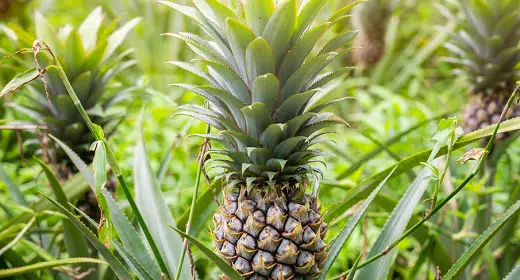by Ocean Robbins: You’re an 18th-century British aristocrat. How do you show your fellow nobles just how rich and powerful you are? John Murray, 4th Earl of Dunmore, did it with a pineapple…
We are proud to announce a new partnership with John and Ocean Robbins and the Food Revolution to bring our readers Summits, Seminars and Masterclasses on health, nutrition and Earth-Conscious living.
Miss Your Chance to Attend for FREE!
Europeans had been fascinated by the fruit since Columbus first encountered it in the tropical lands he despoiled for crown and country, but couldn’t figure out how to grow one until the Dutch invented greenhouses in the 1680s. After that, the ability to produce a pineapple became a clear indication of tremendous wealth.
Murray wasn’t subtle about it either. His pineapple growing hothouse, built into a garden wall in his ancestral Scottish home, Dunmore Park, was topped with a stone cupola in the likeness of — can you guess? — a giant, 46-foot-high pineapple.
Given the effort and expense required to grow a pineapple in the chilly Caledonian lowlands, it was rare for Murray’s family and guests to actually eat one. Instead, they used them as centerpieces at fancy dinner parties, over and over again, until they began to rot.
While the pineapple is unquestionably an attractive fruit (and often referred to as the “King of Fruits”), these days we’re more likely to encounter it in smoothies, fruit salads, and cocktails than in stone follies or rotting table decorations. But the issues of wealth and power that swirled around the earliest colonial exploits still haunt the fruit to this day.
In this article, we’ll examine the origin of pineapple, its nutritional profile, assess its benefits and risks, and see if it’s possible to consume the fruit in a way that’s good for you and the planet. Plus, you’ll learn some fun facts about pineapples along the way.
Facts About Pineapples
Pineapples are a distinctive-looking tropical fruit indigenous to South America. Aside from the meaning of pineapple being linked to hospitality, as well as their association with tropical beach vacations and housing for SpongeBob SquarePants, pineapples have gained favor as a health food, and are particularly celebrated for their anti-inflammatory effects.
The pineapple plant, Ananas comosus, is a fairly short shrub, seldom growing as high as five feet. Contrary to popular belief, pineapples don’t grow on trees; they are actually part of the bromeliad family.
A perennial in its native lands, the pineapple plant produces clusters of fruit that coalesce into a single pineapple. So, is pineapple a berry? Yes, pineapples are a type of berry fruit called a collective or multiple fruit, which refers to the way the berries fuse together to form the pineapple fruit.
Its wild progenitor originated somewhere around Brazil and Paraguay — the Mayan and Aztecs domesticated and cultivated it starting around 3,000 years ago. By the time Europeans arrived, the pineapple was already a staple crop in many indigenous diets.
These days, the biggest pineapple-producing regions include South and Central America, Southeast Asia, and India.
Types of Pineapples

Pineapples come in four main classes, or cultivars. The Smooth Cayenne is the most widely cultivated variety, making up about 70% of all harvested pineapple, and roughly 90% of the processed pineapple in the world. If you buy canned pineapple, it’s almost certainly from the Smooth Cayenne.
Red Spanish pineapples are rounder, more aromatic, and tastier than Smooth Cayennes. They don’t can well and are best when fresh.
Queen pineapples are eaten fresh only, and are the most commonly grown cultivar in Malaysia, Australia, and South Africa.
According to many aficionados, Abacaxi pineapples are one of the most delicious varieties but are hard to grow at scale. So if you get a chance to taste a locally grown abacaxi pineapple in Florida, the Bahamas, or Brazil, savor the opportunity.
There’s also a bioengineered pineapple called Rosé or Pink Glow, named for its pink flesh. Growers in Costa Rica produce it and ship it to the US (minus Hawaii) and Canada. In addition to being served fresh, this pineapple can also end up in cans of fruit and juice.
The patent mentions carotenoid synthesis in relation to creating a new and different-looking variety, presumably to aid marketing. Aside from that, the Pink Glow doesn’t appear to have any other redeeming traits. It can’t hold a tune, for example, or calculate tips, or even remind you to floss. But it does cost about five times as much as other pineapples.
Pineapple Nutrition
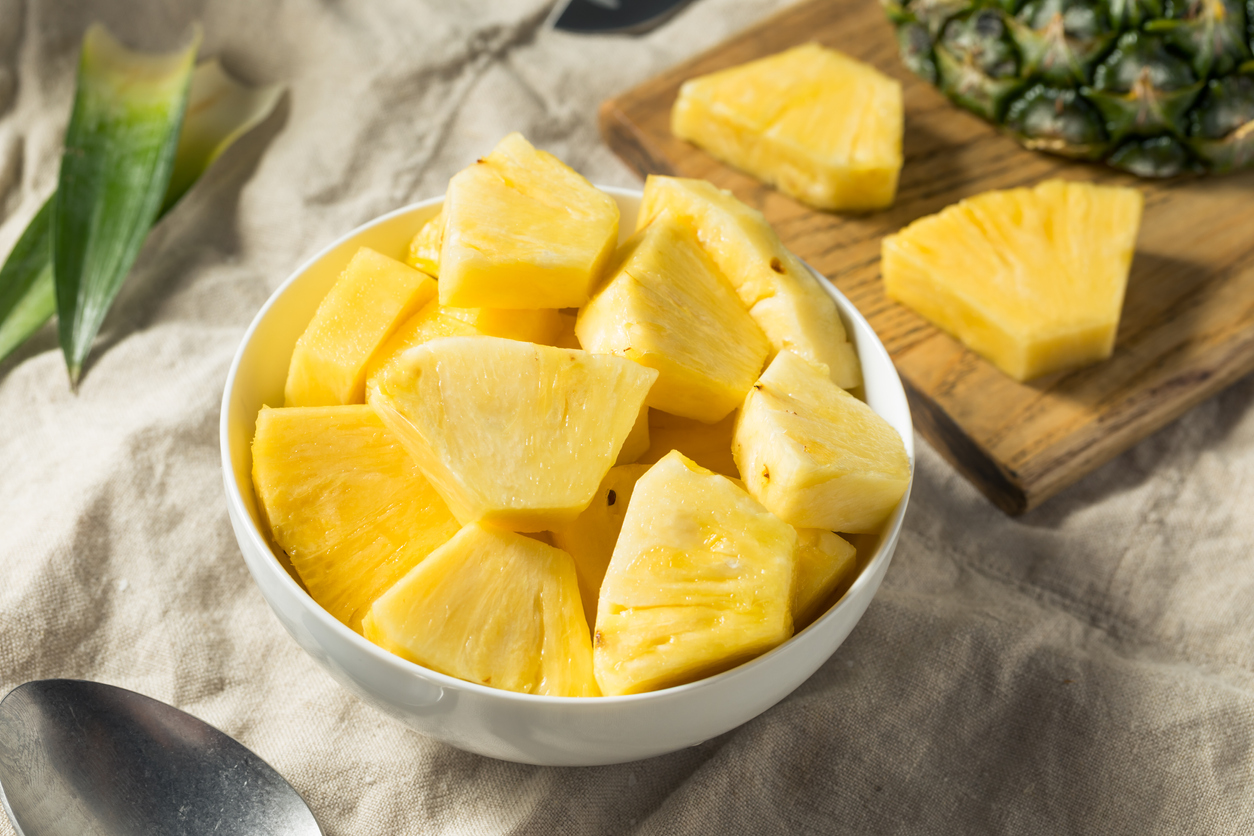
Like most fruits, pineapple is rich in vitamins, fiber, minerals, and phytonutrients — specifically vitamins C and A (the latter as carotene), folate, potassium, and manganese. It’s also a source of simple and complex carbohydrates, in the form of natural sugars and fiber, respectively. While pineapple is fairly high in sugar, it’s also 86% water and low on the glycemic index. Because it’s high in fiber, pineapple is considered a good fruit to eat, even for people with diabetes.
You can see how one cup of pineapple’s nutrition measures up below (Source: USDA):
- 82.5 kcal calories
- 21.6 g carbohydrates
- 16.3 g sugars
- 2.31 g fiber
- 180 mg potassium
- 78.9 mg vitamin C
Perhaps most notably, raw pineapple contains a digestive enzyme called bromelain, which breaks down proteins in the body. (Don’t worry! I’m talking about the ones you aren’t using at the moment; bromelain will not dissolve you from the inside out.)
Pineapple juice has a similar nutritional profile, but with lower concentrations of nutrients due to processing — and unless it’s raw, it won’t have any bromelain. And since juice generally lacks fiber, it has a faster and greater impact on blood sugar than the whole fruit. Canned pineapple also lacks any bromelain, and often includes added sugar in the form of syrup, for preservation purposes.
For these reasons, you’ll get the most nutritional benefit from eating fresh or frozen pineapple as opposed to juiced or canned.
Health Benefits of Pineapples
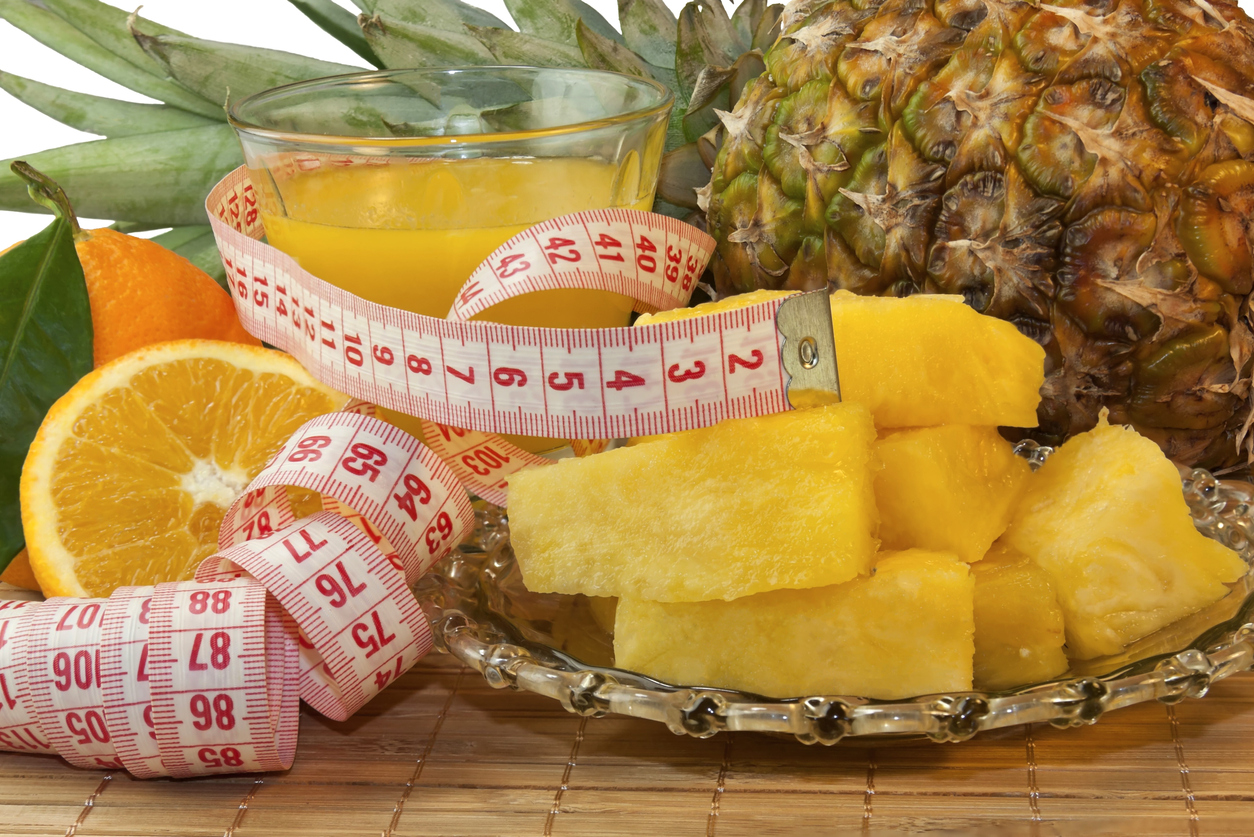
Most research into the health benefits of the fruit focuses mainly on that special enzyme, bromelain.
Anti-inflammatory
A fairly technical review article from 2016 noted bromelain’s “anti-inflammatory, antithrombotic and fibrinolytic affects [sic], anticancer activity and immunomodulatory effects, in addition to being a wound healing and circulatory improvement agent.”
I had to look up a couple of those terms. “Antithrombotic” means it suppresses the formation of blood clots. Fibrinolytic compounds can break up clots once they’ve already formed. And immunomodulatory substances change the function of the immune system, either ramping it up to fight infection or calming it down to prevent an overreaction.
A study from 2021 found that bromelain extracts caused changes in certain biochemical pathways associated with the chronic inflammation of both rheumatoid and osteoarthritis.
Gut Health Benefits
Bromelain is also a nutrient of interest when it comes to gut health. Eating pineapple in moderation has been shown to benefit digestion. It kills some problematic gut bacteria that can cause diarrhea and also displays antifungal properties. Taken orally, bromelain reduces the severity of gastric ulcers and is considered a high-potential treatment for inflammatory bowel disease and colitis.
Anticancer
Bromelain appears to slow the spread of colorectal cancer, at least in mice and zebrafish. (Our view on the use of animals in medical research is here.) A 2014 study that looked at human cancer cells in vitro and mice with colorectal cancer suggested that bromelain nudges cancerous cells to kill themselves off (a process known as apoptosis). It also shows potential against certain types of oral cancer.
Antimicrobial
Bromelain also shows strong antimicrobial properties. It attacks the bacteria that can cause gum disease, as well as pathogens found on the skin that can cause acne. And in early 2021, an international team discovered that bromelain might inhibit COVID-19 transmission by targeting the spike proteins in the SARS-CoV-2 virus.
Metabolic Benefits
Bromelain exhibits positive metabolic effects, as well — at least in rodents. To tease out the mechanisms, researchers in 2018 fed pineapple juice to obese rats (who had been rendered obese through a high-fat diet). They observed that the juice decreased the production of insulin, which shuttles sugar into cells, and leptin, the “hunger” hormone. It also changed some liver functions related to the creation and storage of fat, suggesting that pineapple consumption could possibly help humans preferentially burn fat and reverse obesity.
A 2020 study found that bromelain extract protected mice from fatty liver disease. And in late 2021, scientists published evidence that bromelain could help in treating type 1 diabetes. Rats who received bromelain experienced lower blood glucose, lower cholesterol and triglycerides, and faster wound healing than controls.
Risks or Side Effects of Pineapple
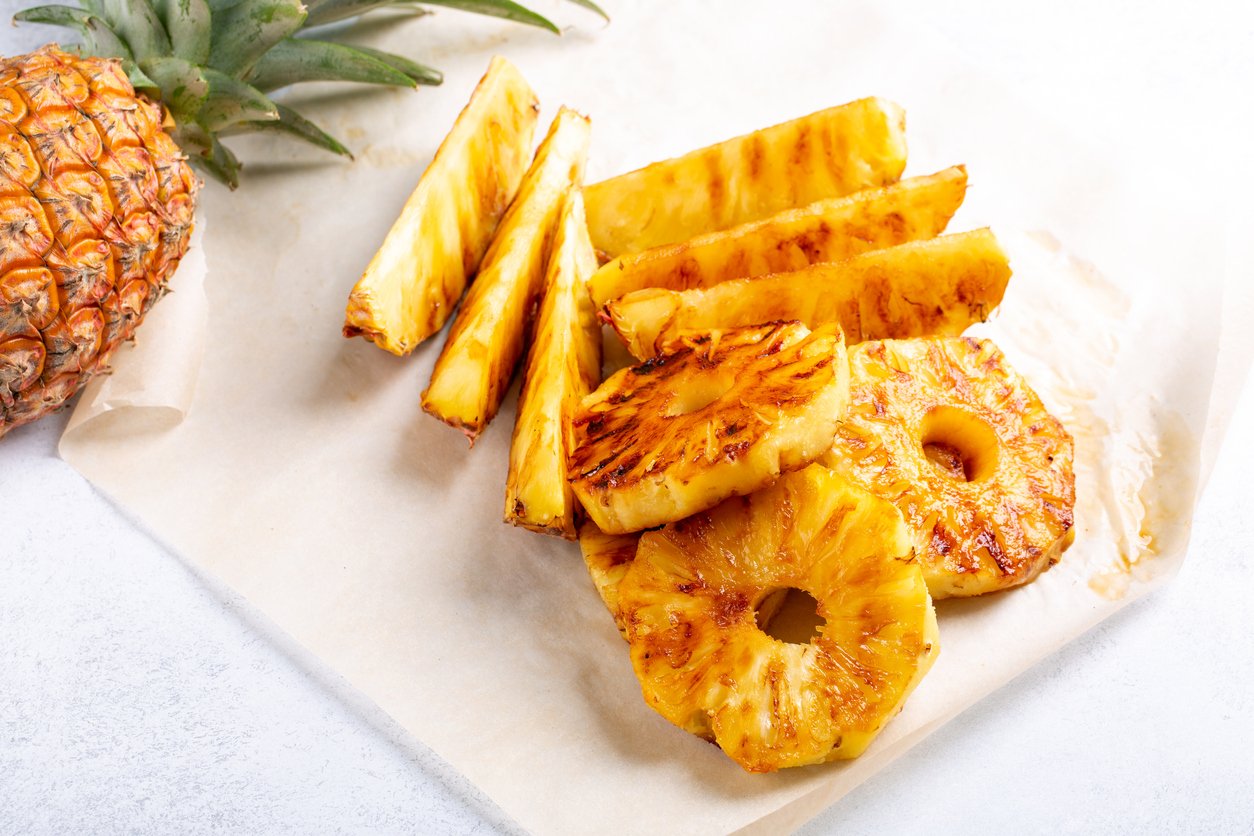
That’s an impressive list of potential benefits from eating pineapple. Before you go all Earl of Dunmore and turn your house into a giant greenhouse (or just start buying fresh or frozen pineapple by the cubic yard), you should be aware of some potential risks and side effects that, while rare, are still worth a mention.
First, the bromelain in pineapples can increase the absorption of medications: antibiotics, chemotherapy drugs, and blood pressure medication, specifically ACE inhibitors. So be sure to check with your healthcare provider if you’re taking any of these meds.
Second, pineapples are associated with certain allergic reactions. An epidemiologic study of oral allergy syndrome in Japan found that the combination of airborne pollen and eating certain fruits triggered symptoms. After melons, pineapples were the most common triggers.
Constant exposure to pineapples can also lead to allergic reactions over time. A case study from 1979 featured a pharmaceutical technician who developed asthma and rhinitis after handling bromelain for years.
If someone already has an allergy to latex, pineapple exposure can cause a cross-reaction. And, there’s also a true pineapple allergy that typically starts with a tingling mouth and tongue, and can also include more serious symptoms like gastrointestinal discomfort or difficulty breathing.
Raw pineapple can also irritate the mucous membranes of the mouth, causing sores, itching, and irritation. That’s the bromelain, breaking down proteins in your mouth. (I know I said it won’t turn you into goo, but that’s kind of what it’s doing to the soft tissues of your mouth before it gets to your stomach, which can digest it like a champ.) If this sensation makes eating pineapple unpleasant for you, you can sprinkle it with salt or soak it in brine water for a minute — or you can cook it, which breaks down the bromelain. Just keep in mind that you’ll lose some of the fruit’s health benefits if you cook it.
Are Pineapples Ethical or Sustainable?
Although pineapples often symbolize tropical hospitality, the history of pineapples can also represent a legacy of colonialism and slavery. The kitchen gardens of early Caribbean plantations grew pineapples to supply white households, presaging the fruit’s displacement of indigenous staples and subsistence crops to feed the colonizers’ hunger for “dessert foods.”
And pineapple soon became a global commodity. George Washington, who first encountered the pineapple in the plantations of Barbados, had them imported from the West Indies, a port in the triangular trade of enslaved Africans.
The first commercial crop enterprise was established in Hawaii in 1886. And as the industry grew and made fortunes for the planters and distributors, other growers followed, often settling on land stolen from the Hawaiian people. Since the fields needed workers, a plantation system was developed. Now that indigenous people couldn’t grow food on their own land, they had little choice but to accept work on the plantations at terms set by their colonial overlords. As demand grew, fruit company owners brought in laborers who they exploited practically without limit.
Pineapple Issues Today
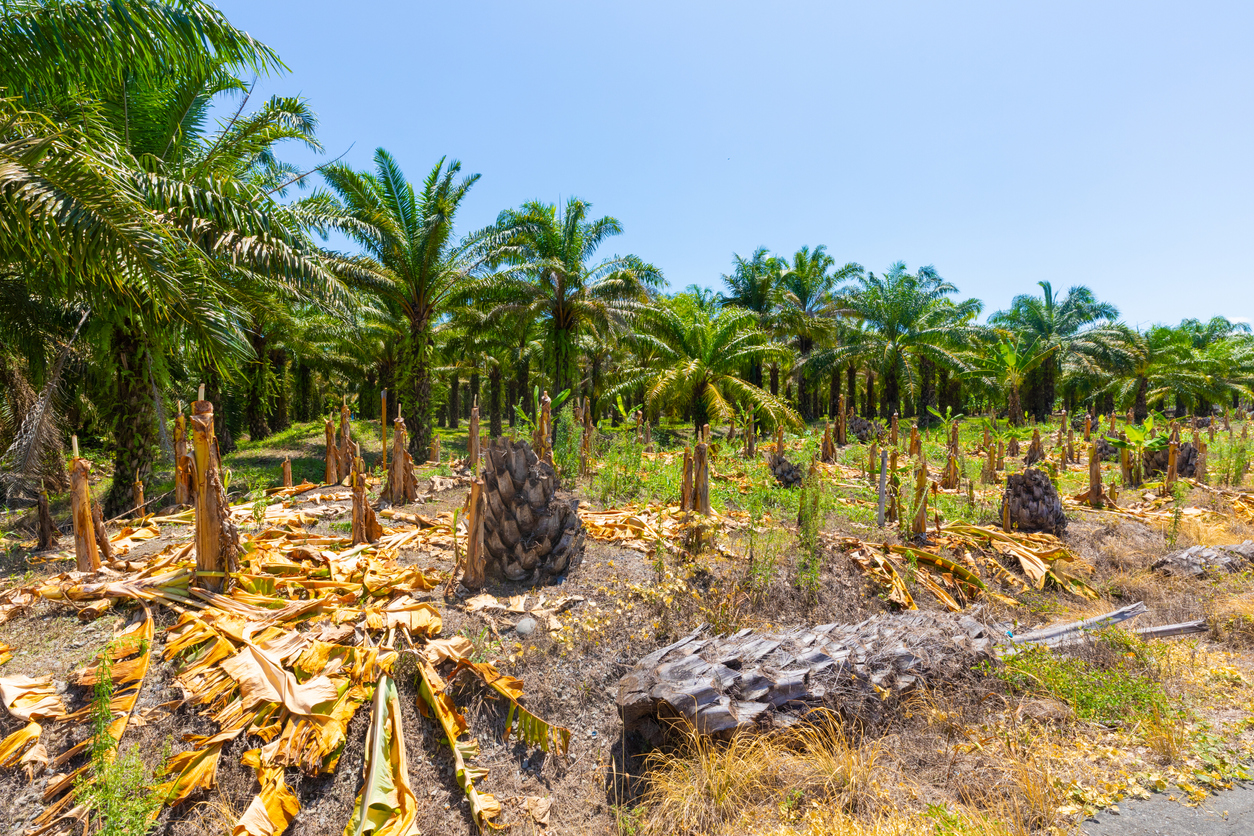
The exploitation of people and land isn’t just a relic of the pineapple’s colonial past. Modern pineapple production is not without its own issues, too.
Costa Rica dominates the global pineapple export industry, with two out of every three exported pineapples coming from its producers. Sadly, the industry has not been a friend to the health of its workers or the sustainability of the land upon which it grows its cash crop.
Pineapple Pesticides
It’s easy to miss the significance of the pesticide issue, as the Environmental Working Group (EWG) includes pineapples in its Clean 15 list, largely due to the fruit’s thick and inedible skin. But the EWG rating doesn’t reflect the harms that pesticides can cause to farmworkers and their environment.
Pesticides and agrochemicals used in growing pineapples on Costa Rican plantations have devastated local communities. A weedkiller called bromacil (which has been banned in the EU) was in use until 2017, and it still pollutes ground and surface water to the point where people are afraid to drink the water. It also harms the livestock on neighboring farms.
Monocultures
Costa Rican pineapples are grown as intensive monocultures, which causes its own problems. The expansion and intensification of pineapple plantations have led to surface and groundwater contamination, soil erosion, and the buildup of sediment in rivers.
An organization called MOCUPP is tracking land use by the pineapple industry in Costa Rica. They’ve found that despite a ban on logging old-growth forests, the profit motive has led pineapple producers to contribute to deforestation in the country. Intensive pineapple farming has colonized important unprotected forests, including wetlands and secondary forests.
This in turn causes displacement of peasant families in Costa Rica and threatens their food sovereignty. And while giving people money instead of making it possible for them to grow their own food may feel like a fair trade (after all, it’s what most people in the industrialized world, indeed the entire world, think of as normal), the poverty wages mean that the workers who are responsible for our tropical smoothies and piña coladas can hardly afford the cheapest, least healthy processed food for themselves and their families. And the working conditions in these plantations, many of which are owned and run by the Dole corporation, may constitute health and human rights abuses in their own right.
The Rise of Fair Trade Pineapples
In response to investigations and activist complaints, Dole and Whole Foods Market have partnered with Fair Trade USA to sell fair trade pineapples that directly benefit pineapple farmworkers in Costa Rica. You can help farmworkers and local economies by buying fair trade and also organic pineapples when possible, thus enabling the workers who are producing your food to avoid most pesticides. And when you’re getting organic produce, you benefit personally, as well.
If you live in another tropical or subtropical country in South America or Africa, or in a subtropical zone in Florida, parts of California, Hawaii, or Puerto Rico, you can get locally grown pineapples from small farms (which may also be grown organically).
How to Cut a Pineapple & Know When It’s Ripe
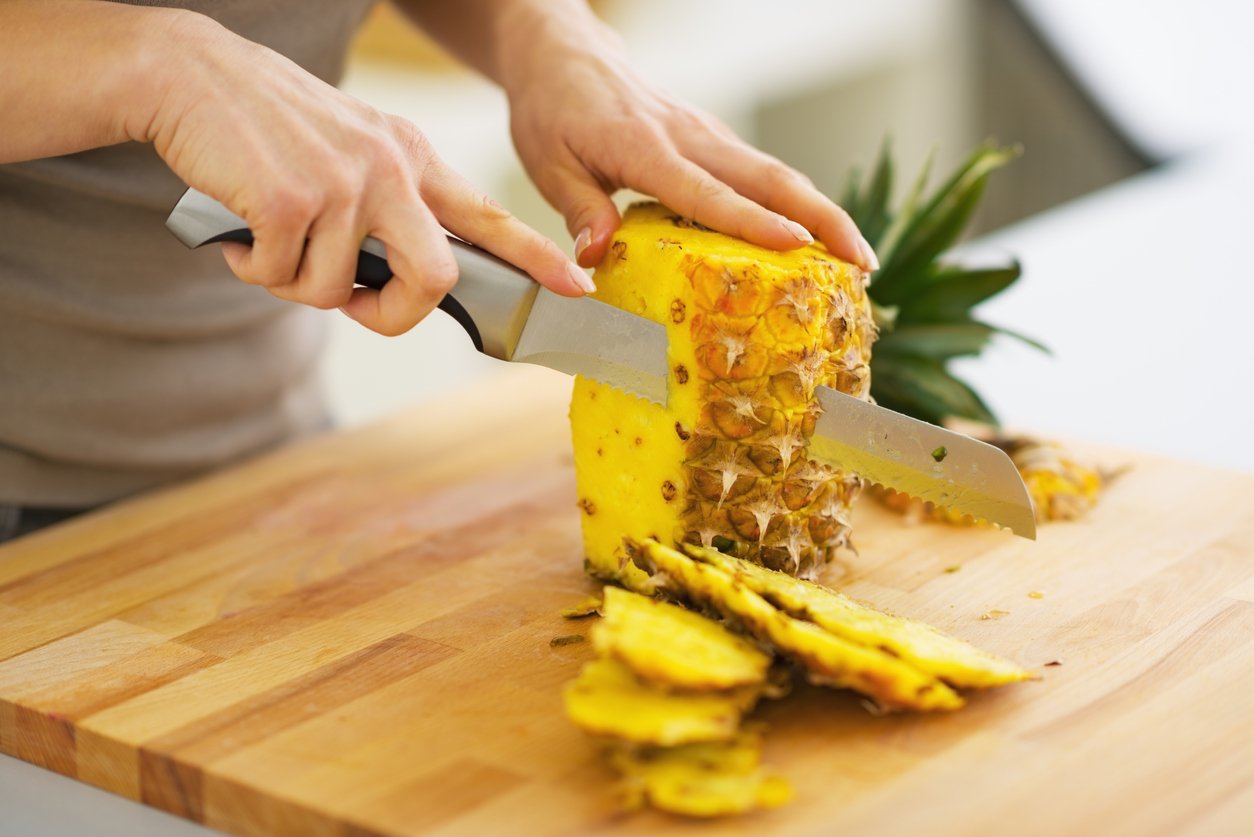
If you’ve ever seen a pineapple display at a supermarket or produce stand, you may have wondered which fruit was ripe, which needed a few days, and which was already past its prime. The key indicators include the fruit’s color, firmness, and smell.
The pineapple should have some golden color to the skin, and not present as all green. When you press the skin, the interior flesh should have a little give to it, and not be hard and resistant or soft and mushy. If you can stick your finger all the way through, you’re either dealing with an overripe pineapple or you should audition for the next Kill Bill movie.
To serve the fruit, cut off the top and bottom and all the skin. What you do next depends on how you want to use the pineapple — whether you want to serve it in strips, cubes, or rings (or just chuck the chunks into a blender.)
But can you eat the core of a pineapple? The pineapple core is tougher and not as sweet as the fleshy part of the fruit, but it is edible.
Here’s a video that shows you exactly how to handle your next pineapple like a pro:
Pineapples Uses
Once you’ve got your chunks, rings, or strips, what can you do with the pineapple to add color, flavor, and bromelain to your life? (Remember that it’s fine to use frozen pineapple, but probably best to avoid canned chunks or pineapple juice with added syrup or sugar.)
Here’s a quick list of ways to use pineapple to spark your own ideas:
- Mixed in Asian stir-fries, curries, and other entrées
- In fresh salsa or ceviche (which can be vegan)
- In leafy salads or fruit salads
- Blended into marinades and sauces
- As a topping for chia pudding, oatmeal, or smoothie bowls
- Grilled and eaten on fruit and veggie skewers
- On pizza (if you’re into that sort of thing; I don’t pass judgment, although I may be thinking it very loudly)
- In frozen desserts, like n’ice cream
- In smoothies, either as fresh or frozen chunks
- Slices or juice can be used in mocktails
- In pies and other warm desserts
Pineapple Recipes
Pineapple is truly one versatile fruit. It can act as a natural sweetener in salads, stir-fries, smoothies, and desserts. It’s also delicious on top of pizza and tacos. Find three recipes below that will give you a “taste” of its versatility.
Make the Sweet and Savory Pineapple Salsa and add it to tacos, grain bowls, or wraps. Double the batch of Pineapple Rice so you have plenty of leftovers all week long. Or create the most satisfying salad ever by making the Barley Salad with Tofu, Pineapple, and Mushrooms. It checks all the satisfaction boxes in the texture, flavor, and nutrition categories. Let us know which you try first!
1. Sweet and Savory Pineapple Salsa
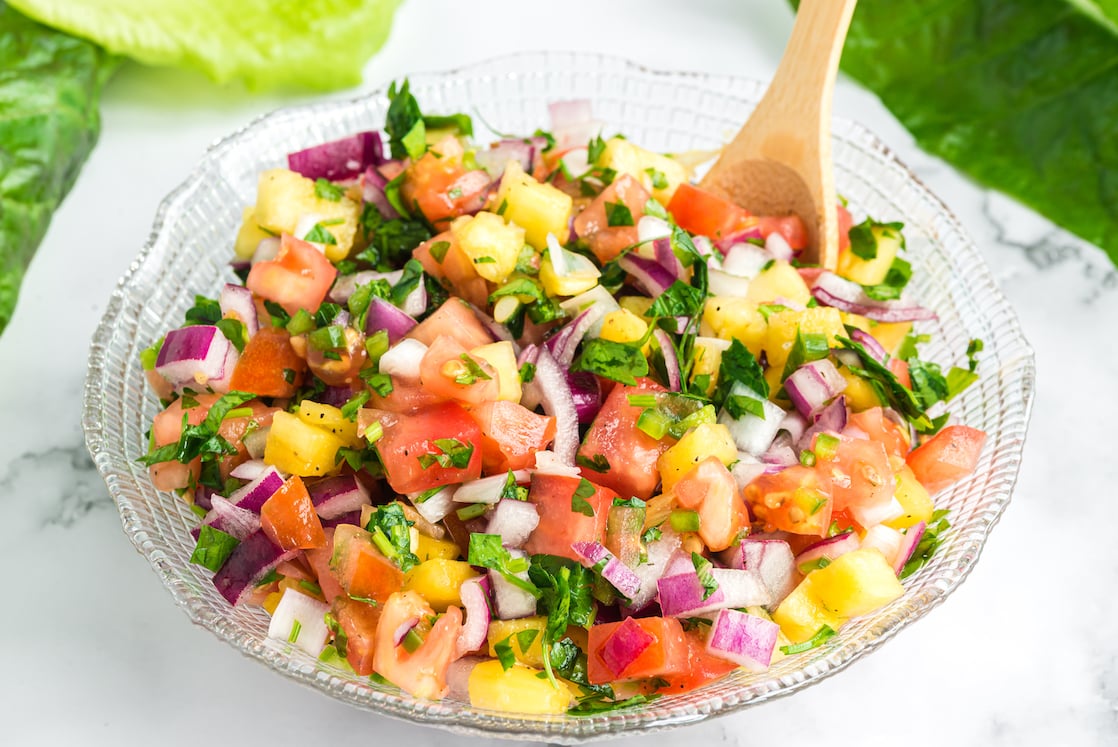
Pineapple adds some natural sweetness to this salsa, which complements the pungent onion, spicy jalapeño, and earthy cilantro perfectly. It also adds carotenoids, bromelain, vitamins, and minerals. So, essentially, you’re upgrading traditional nourishing salsa to super nourishing salsa! Enjoy on top of tacos, salads, or in wraps.
2. Pineapple Rice

Pineapples are one of the most versatile fruits in that they can be enjoyed solo as a snack, added to skewers for grilling, or included in savory dishes like this Pineapple Rice to add some natural sweetness. It’s simple to make with minimal ingredients yet packed with immune-supporting nutrition like vitamin C, carotenoids, and fiber. Make it early in the week and enjoy it as leftovers all week long.
Pineapples Are Good for You!
Pineapple is a generally healthy fruit that contains a powerful digestive enzyme with anti-inflammatory, anticancer, antimicrobial, and metabolic benefits. Although there are some side effects and things to be aware of, for most people, pineapples are perfectly safe — and delicious. The pineapple industry does have a controversial past and present, but as a conscious consumer, you can make informed choices when buying pineapple, such as purchasing organic, fair trade, and local varieties.
Whether you eat pineapple on its own, juice it, or eat it in sweet or savory dishes, its unique flavor is versatile and delightful.
We are proud to announce a new partnership with John and Ocean Robbins and the Food Revolution to bring our readers Summits, Seminars and Masterclasses on health, nutrition and Earth-Conscious living.
Miss Your Chance to Attend for FREE!







